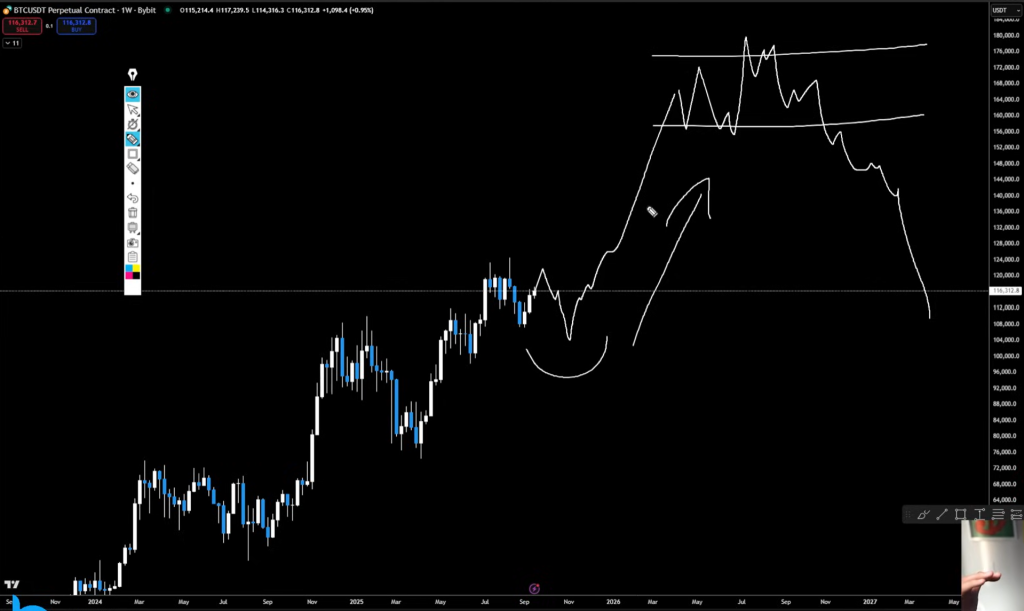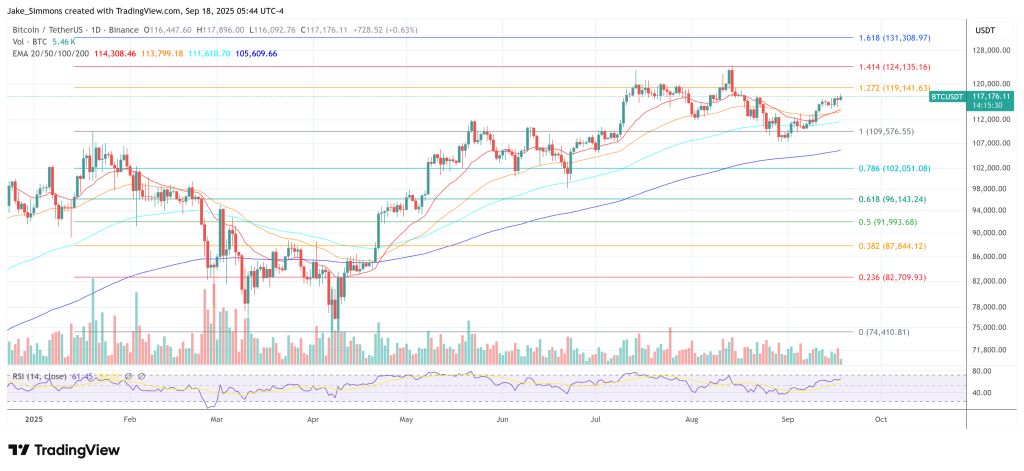The Fed Just Changed Everything For Crypto, Says Top Trader
The Federal Reserve’s first rate cut of 2025 has landed—25 basis points on September 17—and, in Trader Mayne’s telling, that removes the last macro “X-factor” hanging over the crypto market. In a video analysis posted the same day, the veteran price-action trader argued that with the policy move now in the rear-view mirror, crypto can “just focus on the charts,” sketching a roadmap in which Bitcoin posts one more leg higher into new all-time highs before a pullback ushers in a classic altseason blow-off. “We had FOMC today and the rates got cut finally… It’s 25 basis points,” he said. “Now the market’s going to digest it.”
Where Is Bitcoin Price Going Next?
The policy backdrop he’s reacting to is straightforward: the FOMC lowered the fed funds target range by a quarter point to 4.00%–4.25% on Sept. 17, with Chair Jerome Powell describing the move as a risk-management response to weakening labor dynamics and leaving the door open to additional easing this year. The decision drew an 11–1 vote, with newly appointed Governor Stephen Miran dissenting in favor of a larger, 50 bps cut—an unusually hawkish dissent in a dovish direction—while the Board’s implementation note reset key administered rates effective Sept. 18. Markets read the statement and projections as signaling scope for further cuts into year-end.
From here, Mayne’s framework is unapologetically technical. He characterizes Bitcoin’s most recent upswing as corrective relative to the prior impulse and expects price to “push above the mid-range” toward a range high around $120,000–$121,000, where he will watch for rejection at a higher-time-frame confluence defined by a weekly swing-failure pattern (SFP) and an H12 breaker.
If momentum stalls there, he plans to short into a washout to clear out built-up leverage—“HYPE made another all-time high today. PUMP has tripled in the last two weeks… there’s some leverage in the system”—and then buy the dip for what he calls the last parabolic leg of the cycle. “Any sort of dip on BTC, I want to be looking for a long,” he said, adding that a shallow retest in the $110,000–$111,000 area or a deeper sweep of recent lows would both be acceptable springboards if the rebound is decisive.
If, instead, price grinds through the $120,000 s with no signs of exhaustion, Mayne says he has “no problem” flipping to breakout longs above the all-time high once strength is confirmed intraday—an approach that mirrors his playbook from prior expansions (“Once this thing broke out aggressively… you’re looking for longs”). He emphasizes sequence over prediction: the short he’s eyeing is counter-trend—“a pullback in an uptrend”—and the prime objective remains to position for the next impulsive advance.
When Will The Crypto Market Top?
Timing-wise, he situates the prospective cycle top in Q4 2025 or Q1 2026, describing a pattern in which Bitcoin’s final vertical leg into the $150,000 to $180,000 region is followed by distribution while altcoins reprice higher—the archetypal altseason.

“This parabolic leg I think would be the last leg of the bull run,” he said, before outlining notional alt targets consistent with a late-cycle melt-up: Ethereum $5,000–$7,000, Solana $300–$500, Dogecoin $0.50–$0.70. The mechanics, as he narrates them: a last BTC push, a corrective wash, a V-shaped reclaim of the 2024 ATH “very quickly,” then Q4 “mania” with breadth shifting to large-cap alts as Bitcoin distributes.
The technical scaffolding behind that view leans on concepts familiar to discretionary price-action traders. Weekly SFPs (failed breaks of prior extremes) set the trap line at range edges; H12 breakers and order blocks frame high-probability reaction zones; and fair-value gaps guide where liquidity vacuums might fill during a corrective flush.
On structure, he insists the weekly trend remains up, so any short is tactical and any deeper dip must resolve in a swift V-bottom and reclaim of the former highs to keep the cyclical script intact. His invalidation is equally clear: “If we spend any significant time back below [the 2024 all-time high], it’s really bad… I’m probably going to reassess my thoughts.”
Macro, in Mayne’s view, now recedes to the background. The rate cut may have helped pull forward some September strength—“you could argue… the up move we’ve seen on Bitcoin… is in anticipation of this rate cut”—but with the decision made and Powell hinting there “could be another one… there could be two,” his emphasis is squarely on execution: wait for price to trade into the $120,000s and signal weakness for the clean counter-trend short; or, absent weakness, wait for the breakout continuation and ride it. Either way, he’s explicit about the north star for the coming weeks: “Focus on Bitcoin… Any sort of dip on BTC, I want to be looking for a long… Then altseason.”
At press time, BTC traded at $117,176.

You May Also Like

US Spot ETH ETFs Witness Remarkable $244M Inflow Surge

First Ethereum Treasury Firm Sells ETH For Buybacks: Death Spiral Incoming?

